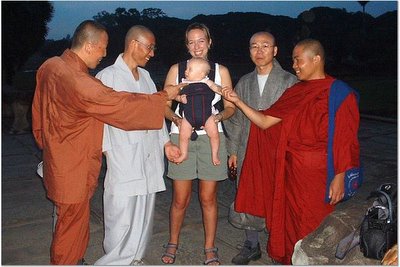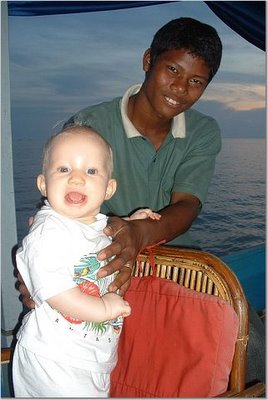The sun's first rays wash the lunaresque Tengger Caldera in a wave of orange light. Mount Bromo is the small smoking crater located in the left midground.
The island of Java is really crowded. Indonesia is the fourth most populated country but its population distribution is rather lopsided. Most Indonesians live on the island of Java. On those cool National Geographic type
Earth at Night posters Java sparkles like a diamond while the rest of the archipelago appears as a black hole. Java is the most developed of the Indonesian islands but it’s shiny appearance at night is mostly because it is jam packed with people. Depending on the flavour of the month for determining population stuff, many demographers put the island at the top of the prestigious “most densely populated regions on earth” list and after this weekends jaunt to
Mount Bromo in east Java I am inclined to agree with their decision.
In order to fully understand a densely populated place you need to get outside of the urban environment and into its rural setting. Jakarta, Java’s and Indonesia’s largest city is crazy crowded but such is the nature of most cities. But the majority of
Java’s population is densely packed into its rural areas. It is difficult to go anywhere on the island without seeing people, lots and lots of people. This reality became glaringly apparent on a recent trip I made to the mountainous interior to see one of Indonesia’s famous natural sites, Mount Bromo.
The large volcano in the back welcomed the day by erupting just as the sunrise began.
Mt. Bromo is one of many active volcanoes on the island of Java. It sits in a giant bowl that contains several active, semi active and dormant volcanic cones. To get there the easy way, which I recommend if you have a small child who thinks that sitting still really sucks, you arrange ahead of time for your hotels and for a guide, car and driver all of which expedite travel time. It cost a bit extra but just subtract it from your kids college fund. Fly to Surabaya, Indonesia’s second largest city, and stay in a nice hotel, we recommend the
Majapahit. After a short stay at this beautiful old hotel, you might be tempted to skip the Bromo excursion but resist this urge and carry on. The next day you embark on a leisurely drive through the Indonesian countryside until you reach the Lava Lodge which is perched on the rim of the enormous volcanic bowl which contains Bromo and the other volcanic cones. After dinner retire early because you will be woken up at 3:30 am, bustled into a Toyota Land cruiser jeep for the hour drive across the “Sea of Sand” and a busy morning of seeing some spectacular natural beauty and a lot of people.
Mount Bromo's ever present sulphur cloud.
There were many signs on this journey that made me stop and say to my self – “Java sure is crowded”. The crowd is not overwhelming but there are people everywhere. The first sign was pretty bizarre and involves a lot of stuff that I will not go into partly because it will take a long time but mostly because it entails engineering and geologic stuff that I simply don’t get. The toll way leading out from Surabaya towards Bromo is under threat of being buried in a mudslide, actually it’s more like a mud ooze than a slide. Evidently, due to human error and gross negligence an oil drill released water from an underground aquifer and as the pressurized water shot to the surface it picked up all sorts of earth which appeared on the surface as mud. The mud spill has turned into a sizeable lake and is wreaking havoc on the people surrounding the affected area. What does this have to do with crowds? The fact that there is large oil drilling operation smack dab in a residential area points to the reality that pretty much anywhere in Java where you put an oil rig is going to be in and around a bunch of people.
The next indicator of Java’s crowds became apparent as we snaked our way up into the mountains that make up the backbone of Java. These mountains reach almost 10,000 feet and many have extremely steep slopes. The majority of these ruggedly majestic mountains are deforested and crop cultivation is evident on all but the steepest slopes. People need food and fuel to cook the food and there are a whole lot of them meticulously cultivating the mountainous interior of Java.
Hanging out with some other bundled up travelers waiting for the sun to rise over the calderra.
The third sign of Java’s vigorous population appeared at the popular scenic overlook where people gather to watch the sunrise over the volcanic bowl which contains Bromo and other volcanic cones. We approached the lookout at five in the morning after driving for an hour across the “Sea of Sand”, the most desolate piece of land I have ever driven across, and inching up some of the steepest chunks of pavement I have ever inched up. Near the summit we were greeted by a sea of people, actually not a sea because a sea spreads out, there is not much spreading on top of a mountain, so it was actually a huge blob of people. We had to park our Landcruiser several hundred kilometres below the peek because there were so many other vehicles parked on the hill. Industrious youngsters on scooters were taking advantage of the situation to shuttle people from the beginning of the make shift parking lot to the top of the mountain and the lookout point. It was quite a crazy scene with motor scooters weaving in and out of parked jeeps and bleary eyed tourists all in the wee hours of the morning. At the lookout we jockeyed for position and kind of saw the sun appear – through a lot of wool capped heads (they sell Bromo toques for those unprepared for the ‘cold’) and woolly mitten covered hands holding up various photo taking devices above the crowd trying to get a lasting memory of the sunrise. After the sun came up the crowd dispersed a bit and I could finally take account of the teeming mass of humanity that had amassed on this mountain top. It was a long weekend and apparently this is one of the things that lots of people living on Java do for fun.

Peering into the crater of Mount Bromo.

The view from the top of Mount Bromo over the Sea of Sand. Below, the Hindu temple and throngs of people are visible.
After the sunrise we drove around the rim of the bowl that gave a commanding view into the “Sea of Sand”. The scene below was reminiscent of the original Mad Max movie as 100’s of vehicles made their way across the ash covered landscape raising huge clouds of dust into the air. We soon made our way into the bowl and joined in on the Mad Max dash. Greeting us at the foot of mount Bromo were hundreds of porters and their horses offering transport up to the base of Bromo for the blob of people who had migrated from the scenic overlook. Foregoing the horses we walked up the hill, which was tiring, and then up 250 steps to the top of the Bromo crater. From there you have a commanding view into the crater and the sulphur enriched cloud spewing from its innards. After this it was back down to the jeep, another mad dash across the Sea of Sand and up to the hotel for a nice breakfast. Then back in the car for a ride down to Surabaya which usually takes 3 hours. But due to the closing of the toll road because of the mud ooze it took about 5 hours as we joined the throngs of motorists forced from the toll onto a mediocre sized side road.

Not so tiny baby anymore at the foot of Mount Bromo.
The trip was not without its hassles but it was incredible in all of its bizarre facets. Going to Bromo is a must do in Java and when you do, take a moment to consider that you are indeed in one of the most crowded and yet stunning places on our planet.
 The Amandari hotel built overlooking a gorge on the outskirts of Ubud. I think it is in one of those "1000 Things You Should See During Your Lifetime" books. I was too busy trying to conjure up the photos I had just erased to fully enjoy the experience.
The Amandari hotel built overlooking a gorge on the outskirts of Ubud. I think it is in one of those "1000 Things You Should See During Your Lifetime" books. I was too busy trying to conjure up the photos I had just erased to fully enjoy the experience.





































































